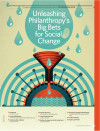If a core principle of civil society is to advance private action for public good, then “big bets” may be a critical instrument to help us achieve this objective. I believe big bets are an important development for philanthropy because of two trends.
Unleashing Philanthropy’s Big Bets for Social Change

This collection of articles, sponsored by The Bridgespan Group, explores how big-bet philanthropy is changing the ways that social entrepreneurs, nonprofit organizations, donors, and advisors are working to have an impact on major social challenges.
-
Introduction to Unleashing Philanthropy’s Big Bets for Social Change
-
Becoming Big Bettable
-
Reimagining Institutional Philanthropy
-
Big Gift, Big Impact
-
Big Bets Are Important. But So Is a Big Heart.
-
Renewing Common Purpose and Collective Action
-
Empowering Nonprofits
-
Hacking the Bias in Big Bets
-
Doing More With Big Bets
-
Learning From Competition
-
From Promising Model to Major Investment
-
Big Bets, 2017-2018
-
Investing in Population-Level Change
-
Profiles of Big Bets
The first is the increasing aggregation of wealth into fewer and fewer hands. We have a philanthropic structure that has been set up to, in a sense, redistribute wealth. When an individual’s or a generation of family members’ wealth is so vast that it is unimaginable to possibly spend it, the practical reality is that the few who have so much will need to give it away in larger amounts—that is, start making bigger bets. Unless there is a significant change in the tax code, that is the only way we’ll see a substantive redistribution of wealth.
The second development is that the nonprofit sector has matured such that more organizations beyond universities and hospitals are prepared to absorb and deploy seven- and eight-figure gifts. We are seeing increasing numbers of nonprofits evolve beyond service delivery to focus on solving large-scale social problems, thereby creating the coin-of-the-realm investment opportunities that many philanthropists seek. There are just more opportunities for philanthropists to make big bets on pressing social and environmental issues.

The expanded marketplace for big bets, however, must also contend with countervailing trends, particularly rising populism that is shifting from a general dislike or distrust to outward animosity toward “elites” and large institutions. In this light, big bets—insofar as philanthropy is viewed as inherently nondemocratic—can be perceived as an unwelcome expansion of power by elites and a tool to protect their self-interest, as opposed to a measure for driving meaningful, transformative change.
I would argue that big bets present an unprecedented opportunity not only to redistribute wealth but also to rebalance power within the philanthropy sector. Strategic philanthropy, that is, approaches where the funder’s and not the grantee’s strategy dominates, may never match this opportunity. With big bets, donors can essentially turn over their resources with the informed belief that people of goodwill are going to bring the best professional expertise, vision, and values to bear on what are inherently adaptive challenges. To achieve this, philanthropists need to be more flexible and more willing to relinquish control. I believe there are a few things donors can do to increasingly shift in this direction:
Respect | Donors can begin to reset the power dynamics by approaching grantees with respect, including being mindful of the costs they impose on nonprofits and offering transparency about their grantmaking process. The MacArthur Foundation’s 100&Change competition stands out. MacArthur has by all accounts put together a fair and open selection process. They invested deeply in publicizing the process steps and decision-making criteria. They pulled together a large external committee to democratize the adjudication process. And they progressively upped what they were asking of applicants, graduating to more time- and resource-intensive requests only after whittling the field down to a set of applicants who were highly likely to get significant support—be it from MacArthur directly or through MacArthur’s introductions to other funders.
Trust | Donors can signal their faith in leaders of organizations by providing them with general operating grants and unrestricted money. Blue Meridian Partners, for example, offers flexible, unrestricted, long-term grants of up to $200 million each and gives funds to support organizations’ ideation and development of theories of change. Impressively, 70 percent of the Hewlett Foundation’s grants are general operating support.
Humility | Before launching a new venture, donors would be wise to look for similar organizations and initiatives. If a donor needs to launch a new venture instead of investing in an existing initiative or organization, then that new effort should be informed by genuine community engagement and learn from or build on past efforts and experiments. Take, for example, El Pomar Foundation, one of Colorado’s oldest and largest. It convened councils in 11 different regions and, rather than tightly prescribing their work, gave each one an allocation, saying in essence, “You all self-determine what it is you want to do. Tell us how you are measuring progress, and then we roll up what we are learning across the 11 regions.” El Pomar also convenes these community leaders with state and national policymakers, informing policy formulation with community input and trusting local leaders to speak for themselves.
Getting the best from big bets will require more openness to turning over resources to those who have the deep knowledge of and proximity to the problems they are working to solve. Big bets are just that—bets. If you can pull them back, reign them in, and fully control them, then you have yet to make your bet.
Editor's note: A previous version of this article mistakenly identified the number of regions for which El Pomar Foundation convened councils. We regret the error.
Support SSIR’s coverage of cross-sector solutions to global challenges.
Help us further the reach of innovative ideas. Donate today.
Read more stories by Dan Cardinali.

